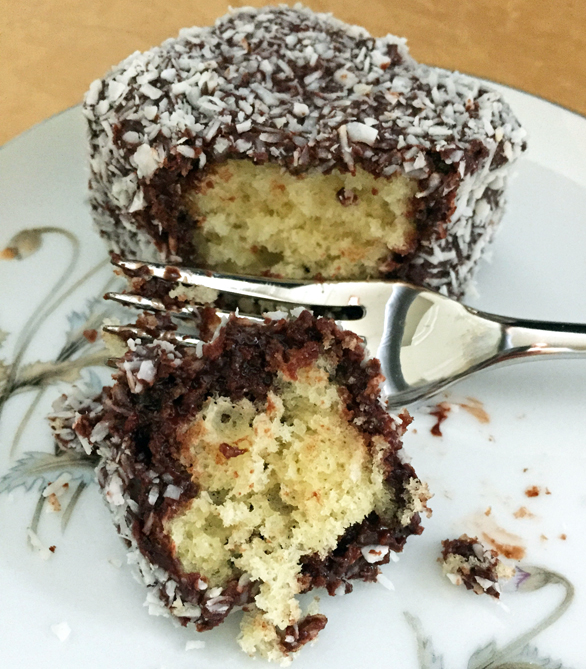This is a story of how best-laid plans and good intentions kinda went off the rails. ICYMI, January 26 was Australia Day. Kind of a big deal — national holiday and all that — Australia Day is the anniversary of the arrival of the First Fleet at Port Jackson, aka Sydney Harbor. Lacking a better analogy, it’s like 4th of July for Australians.
Over the years, I’ve found little ways to my celebrate Australia’s national holiday here in the US — cracking open a bottle of Hunter Valley semillon, digging into my stash of Cherry Ripes or Monte Carlos, or attempting some savory recipe from my childhood (fish cakes? spaghetti on toast?). This year, in honor of said holiday, I was all set to mix up a batch of lamingtons and post some lovely food porn for you all — with recipe, of course, so you can DIY.

A lamington, if you’re not familiar with this staple of Australian bakeries and home cooks, is a square or rectangular slice of yellow sponge cake, dipped in chocolate icing and then rolled in shredded coconut. (Hello?! Yum!) There are fancy variations as well — cream-filled, jam-filled, cream and jam-filled, and custard-filled – but the classic lamington is the most common and probably best-loved. They’re the stuff of school lunches and childhood birthday parties.
It’s been a year or so since I’ve made lamingtons, but my last batch was pretty damn good. The recipe, which I adapted from The Australian Women’s Weekly Easy Entertaining Cookbook, worked perfectly. Putting my CIA training into practice, I made the cake a day in advance, then cut, iced, and finished the lamingtons the next morning. Voila!
This time around, I decided to make and assemble everything in one day. I baked the sponge cake in the morning and made the chocolate icing in the afternoon. All that was left was coating that tender cake in rich chocolate icing. What could possibly go wrong? (That’s what we call foreshadowing, folks.) The sponge cake was buttery and light, the chocolate icing gooey and oh-so-chocolatey.
I figured I’d assemble the whole shebang in 15 or 20 minutes and relax for the rest of the day. I dipped the first cake into the icing, then rolled it in coconut. Perfect. The second one? Not bad, but things were already getting a bit sticky and crumby in the icing bowl. By the time I got to the fourth and fifth cakes, the icing was cooling a bit and sticking to me, the bowl, and the counter, but not to the cakes. Nope, in fact, I was losing half the cakes in the icing bowl; they were breaking as I lifted them out! WTF?!
After reviewing the recipe, reheating the icing multiple times, and finally remaking the icing, it dawned on me: I hadn’t let the cake rest long enough. <groan> It was way too delicate to ice so soon after baking and needed to “stale up” a bit, either by sitting on the counter uncovered overnight, or in the refrigerator for about six hours. Ugh.
And this is why you want to make notes on your recipes. Those little things that you add or change — or that didn’t work. Yeah, you want to remember those when you go back to a recipe months or even years later. So, note to self: next time make the cake a day in advance and let it dry out a bit! In the end, I muddled through and finished the batch, but not without some casualties and a lot of frustration. Don’t make the same mistake. Always read recipes before you start cooking and make notes when you’ve finished. You’ll thank yourself later.
Lamingtons
Yield: 24 cakes, approximately 2″ square
Adapted from The Australian Women’s Weekly Easy Entertaining Cookbook
The lamington sponge cake is light and buttery, with a texture that falls somewhere between a chiffon cake and a classic American butter cake. Be sure to let it rest and dry out a bit overnight before cutting, icing, and finishing in coconut. Freshly made sponge is too delicate for the sticky chocolate icing and will crumble as you dip the pieces.
Part I: Sponge Cake
Make sure all ingredients are at room temperature before making the cake. I typically bring eggs to room temperature by setting them in a bowl of warm water for 15-20 minutes, although you might find eggs are easier to separate when they’re cold.
Tip: Place plastic wrap directly on the yolks after separating eggs, to prevent the from drying out or getting a “skin.”
Ingredients:
207 grams sugar
108 ml water
168 grams butter, softened
1¼ tsp vanilla extract
4 eggs, separated
247 grams all-purpose flour, plus 17 grams baking powder, sifted together

What You Need:
Stand mixer with paddle attachment
Extra mixer bowl and whisk attachment or separate bowl and hand mixer (for egg whites)
Rubber spatula
9″ x 12″ x 2″ baking pan
Parchment paper
Offset spatula, preferably with 6″ blade
How To:
- Preheat the oven to 350°F.
- Butter a 9” x 12” x 2” baking pan, line pan bottom with parchment paper, and butter parchment paper.
- Combine sugar and water in pan, stir over heat until sugar is dissolved.
Bring to a boil, turn off heat, and remove pan. Cover pan and let syrup cool to room temperature before continuing. - Using a stand mixer with paddle attachment, beat the butter until pale.

Beat the butter until pale, about three minutes on medium-high speed I start my mixer on a low setting to get things going (and so that bits of butter don’t fly out of the bowl), then work my way up to medium setting of 6 or 7 for about three minutes.
- Scrape down the sides, then with the mixer running, add egg yolks one at a time, beating until incorporated.
Add each yolk on a low speed, then incorporate fully at medium speed. Scrape sides in between additions as necessary. - With the mixer running on medium-low, stream in the vanilla, again beating until fully incorporated.
- Again, with the mixer running, gradually add the sugar syrup in a thin stream until fully incorporated.
- Scrape down the bowl, reduce the mixer’s speed to low or “stir” mode, and add the flour in two batches — just until incorporated.
You want to mix just enough so that the dry ingredients are no longer visible. Overmixing will activate the gluten and result in a tough cake. - In a separate bowl, beat the egg whites with electric mixer until soft peaks form.

We’ll call them medium-soft peaks Imagine a wave that crests, then gently folds back on itself — that’s a soft peak. If you end up with medium peaks (soft crest, but doesn’t fold back on itself) as I did, don’t fret; your cake will still turn out soft and delicious.
- Using a rubber spatula, gently fold the egg whites (by hand) into the cake batter in two batches.
- Turn the batter into the prepared baking pan, using an offset spatula to spread the batter evenly to the edges of the pan.
- Bake for approximately 25 minutes, until the top of the cake is lightly golden and the cake is starting to pull away from the sides of the pan.
- Turn onto a wire rack covered with a piece of parchment paper to cool.
- Leave the cake on a cutting board overnight, covered loosely with a kitchen towel or piece of foil.
Part II: Chocolate Icing and Assembly
Make sure you prepare the cake and set up your “assembly line” before making the chocolate icing so that you can start dipping cakes right way. The icing sets up quickly, particularly in cool weather, so work efficiently. If the icing gets to firm or sticky, reheat in the microwave as necessary.
Ingredients:
664 grams powdered sugar
70 grams unsweetened cocoa powder (I used Valrhona)
120 ml whole milk, plus a little extra
225 grams shredded, unsweetened coconut
What You Need:
Large microwave-safe bowl for chocolate icing
Rubber spatula
Medium bowl for coconut
Two dinner forks
Sheet pan or cookie sheet, lined with parchment paper
Wire rack
How To:
- Cut cake into 24 pieces using a long, serrated or thin-bladed knife.
You can either eyeball things or use a ruler to mark and cut the slices. - Set up your “finishing station” on a table or section of countertop. Working left to right, you’ll place the cut cake pieces, bowl of chocolate icing (which you’ll make next), bowl of shredded coconut, and sheet pan with wire rack in it.
My counter sections are short, so I placed the sheet pan with wire rack behind the icing and coconut bowls.
Assembly station for lamingtons: cut cakes to the left (not shown), icing bowl, coconut bowl, and wire rack above - Sift the cocoa powder and powdered sugar together into the large, microwave-safe bowl.
- Add milk, stirring with rubber spatula until all ingredients are combined. The glaze will have a paste-like texture.
- Warm the icing in the microwave in 25-second increments, stirring in between until warm and texture is liquid and spreadable.
If the icing still seems too thick and unworkable after 2 heatings, mix in a teaspoon of milk .When icing is ready, place the bowl in your assembly line. - Working with one cake at a time, use the forks as extensions of your hands to dip and coat the cake in icing, (scraping excess on the edge of the icing bowl).
- Immediately place the iced cake in the bowl of shredded coconut and coat completely.
- Place coated cake on wire rack.
As the icing sets up a bit, you can use your fingertips to “square up” the sides, evening out any bumpy sections of icing. - Repeat with remaining cakes.
If the glaze starts to cool and set up in the bowl, return to the microwave and heat for 20-second intervals until it is fluid again. - Let icing set up completely for 2-3 hours at room temperature or place finished cakes in the refrigerator for an hour.
- Serve finished lamingtons at room temperature or store in a cake tin or ziplock bags for several days.







Those look awesome!
Sent from my iPhone
>
Thanks! Despite not letting the cake rest overnight, the “survivors” are delicious.
I put the cake in the freezer for an hour,made it easier to dip in choc icing
Thanks for sharing that helpful tip, Barbara!
Anni – excellent advice. As an ex-pat aussie about to embark on some lamingtons for Australia Day for my colleagues, was double-checking the ‘bake the sponge ahead of time’ concept as will also be making a pav, some meat pies, etc.
Love that you enjoy Hunter Semillon – i’m from the Hunter Valley and semillon is my fave white wine.
Thanks Susan! So good to hear from you. Hope your Australia Day celebration was a good one!